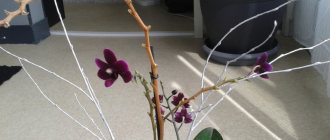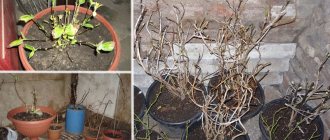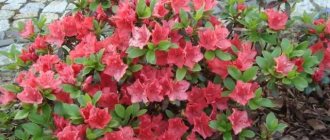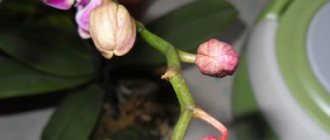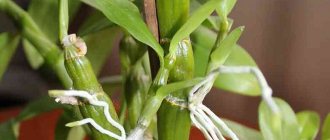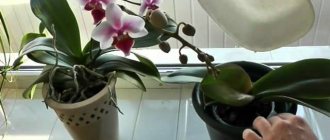The answer to the first question asked in the title is different for each grower. Some people believe that orchid flower stalks should not be touched until they dry out (ideally, this should be the case). Others are sure that the arrow takes away the plant’s strength, and therefore it needs to be “helped” by freeing it from the part that has served its purpose.
Ideally, there is really no need to cut off the peduncle and thereby speed up the development of the plant. It is unlikely that anyone does this in the natural habitat of an orchid, i.e. in wild nature. Another issue is growing the plant in latitudes that were not originally intended for this. You can, of course, bring the conditions of keeping the orchid as close as possible to the original ones, but you still won’t be able to complete this task completely. Hence the problems: a long period of dormancy, falling buds, stunting and even rotting or drying out of the plant. For this reason, the orchid has no need to waste its energy on a faded arrow, and it certainly needs to be trimmed. Another question is how to do it correctly.
Is it possible to prune, is it necessary to do it?
Orchids are very beautiful ornamental plants, most often used for greenhouse planting. The most popular varieties for home planting in Russia are the following genera:
- Cattleya.
- Phalaenopsis.
- Dendrobium.
Each of them requires proper care, including timely circumcision.
Experienced flower growers believe that orchids should definitely be pruned , since they are very delicate and fragile flowers, and dead remains take away vital energy and vitamins.
It should not be overlooked that not all varieties of orchids require this, because they are capable of blooming several times on one peduncle.
Pruning is most often done with those arrows that have already dried out and definitely will not recover.
Peduncle condition
There are times when it is not known what variety a flower belongs to. In this case, it is unclear whether it is necessary to wait for the orchid arrow to dry completely or whether it can be cut off immediately after flowering. In this situation, it is best to pay attention to the condition of the peduncle.
green stem
If the stem remains juicy and green, it does not need to be shortened at all. The plant may bloom again. This is an undesirable phenomenon if it occurs during the natural dormant phase of the flower, because weakens it. For some varieties (such as Phalaenopsis), repeat flowering is the norm if it occurs in spring or summer.
In the spring, you can also shorten the arrow. Then the reproduction of the orchid by lateral shoots will accelerate.
It is necessary to cut off the green peduncle to prevent late flowering during the dormant period.
Dried brown stem
If the flowering shoot has completely dried out, it needs to be removed. In nature, this process occurs on its own. At home, it is necessary to trim the peduncle. It not only spoils the aesthetic appearance of the plant, but can also become an environment for the development of harmful bacteria.
Wilting with dormant buds
If the stem is generally green, but the top begins to turn yellow and withers, partial or complete pruning is required. In the spring, in order to stimulate dormant points and cause new flowering, you can shorten them. However, this does not guarantee re-blooming.
If the peduncle fades in the fall, it is better to remove it completely, providing conditions for a dormant period.
How to choose the right time?
For orchids growing in Russia, the best time is considered to be from the beginning of October to the end of November. By this time, the buds on the shoot have already faded; there should not be a single faded bud left before you start cutting off part of the peduncle. If the stem is partially dry, you must wait for it to dry completely.
Signs that pruning is necessary:
- the arrow has completely turned brown or dried out;
- a bud does not appear from a green shoot for 6 months;
Almost the most popular variety of orchid, blooming on Russian window sills, Phalaenopsis differs slightly in the time of cutting. Its arrows, as a rule, remain green after flowering, misleading inexperienced gardeners. If the goal is to quickly renew flowering, then the peduncle is cut off as soon as the last bud falls.
Since Phalaenopsis flower stalks remain green, they do not need to be cut off . But then new shoots will begin to grow from them, which will grow in all directions, since these will not be new flowers, but flower stalks. Growing in this way, a strong load will be placed on the stems, so flower growers themselves decide on the appearance of the plant.
Why trim the peduncle after flowering?
Orchids, like most other plants, go through certain phenological phases - periods of the year that are characterized by changes in the state of the flower. One of these periods is the flowering phase. This is followed by a dormant period when the plant sleeps and gains strength to form the next buds.
If you do not trim the stems on which the inflorescences form, new flowers may appear. Extending the flowering period disrupts the plant development regime established by nature. The flower becomes exhausted, subsequent flowering becomes less abundant or may be absent altogether.
Partial or full cutting
The possibility of removing flower stalks partially or completely depends on the type of branching of the shoots the plant has. Among the domestic orchids, the following are distinguished:
- Monopodial type - the plant has a vertically located straight stem on which inflorescences and new shoots are formed.
- Sympodial type - the flower has horizontally growing pseudobulbs, from which flowering shoots appear.
The first type includes Phalaenopsis, Vanda, Brassavola orchids and others. They can be subject to partial or complete pruning. The choice of one or the other depends on the external condition of the faded stem:
- If the arrow begins to fade, dries up, it is removed.
- If it remains green, partial pruning of the stem is possible to stimulate the awakening of dormant buds and the appearance of new inflorescences. However, repeated flowering weakens the flower.
Important! It is not recommended to remove stems that retain freshness without special reasons (disease, pest damage) - after surviving the dormant stage, they will produce new shoots or children.
The second type includes Cattleya, Cymbidium, Dendrobium and other species. They can prune shoots that have stopped flowering only after they have completely dried. This feature is due to the fact that these shoots are part of the plant’s nutritional system. Their untimely removal can lead to the death of parts of the flower (leaves, stem tubers) due to lack of nutrients.
Step-by-step instructions: how to carry out the procedure correctly?
If, after all, a decision has been made to trim the peduncle, it is necessary to carry out the procedure correctly, following the instructions on how to cut off a dry shoot so that the flower can continue to delight with its flowering.
Required Tools
Secateurs are the best tool for pruning , according to the general opinion of all florists. It almost does not injure the plant, does not leave hangnails and does not damage the leaves. It is dangerous to use other tools on such a fragile beauty.
The last resort is scissors with thick blades. It is better to wear rubber gloves on your hands to prevent juice from getting on exposed skin.
Before the procedure itself, the pruning shears are disinfected . Alcohol or bleach solution is suitable for this. If you don’t have these disinfectants, you can simply hold the blades in boiling water or on an open fire on a stove burner. This will help prevent infections from getting into the wound.
Finding the right point on a dry branch that had flowers on it
To determine the cutting point at home, the plant is first inspected. If the stem begins to become covered with dormant buds, the orchid is cut at least 1 cm above them. However, nothing may appear from there in the future, then you can completely remove the stem. Sometimes this pruning method is used for propagation.
Or trim the stem at the base, leaving a shoot 3 centimeters long. This method is usually used when the peduncle has completely dried out, when the cavity inside the arrow is clogged and it needs to be removed.
Process
Having chosen the pruning method, you can proceed directly to the process itself. Approximate cutting steps :
- Inspect the flower and determine the exact location of the cut.
- Put on gloves after washing your hands.
- Disinfect the instrument and partially the gloves.
- Without touching any extra stems, peduncles, or leaves, carefully make a cut at any angle, without tugging at the part to be cut.
- Since an infection can get through the “wound,” it must be treated. This can be done with ground cinnamon, activated charcoal or charcoal.
- If the peduncle is not pruned “at the root,” then there will be a cavity inside, which can rot from moisture entering during watering or from getting into the soil. It definitely needs to be closed. Wax or paraffin is suitable for this.
You can cut off dry leaves and stems immediately at the root, which remain like this for a long time.
Treating a damaged area on a faded arrow
Treatment of the cut site is mandatory, since an infection can get through the “wound” and it must be treated. This can be done with ground cinnamon, activated charcoal or charcoal.
Pruning an orchid after flowering
Orchids in general try not to be pruned in the generally accepted sense, therefore, in the rules for caring for these plants, the term “pruning” usually hides the principles of pruning the peduncle. But this is one of the key points when breeding orchids. Knowing how to properly prune an orchid after flowering and what to do afterwards to prevent the plant from getting sick will help the orchid grower preserve the flower and speed up subsequent flowering.
Even if the orchid is a species that blooms once a year and the stem dries out after flowering, there is no need to try to pull it out. The peduncle is cut at a distance of about 3 cm from the rosette. At the same time, in the future it will serve as a “handle” for the plant when transplanting. As always, the most popular phalaenopsis and its hybrids stand apart from other orchids.
Due to the almost year-round flowering, phalaenopsis has its own rules on how to prune a faded orchid. For this operation, you can use regular scissors or, if your hand is steady, a sharp knife. But it is very easy to damage the leaves of a plant with a knife. Another option is pruning shears. Specially designed for cutting branches, the pruner causes minimal damage to plant tissue. For phalaenopsis, this nuance is especially important, since it is quite difficult to correctly trim a peduncle that has not dried out but is laying new buds. Scissors compress the stem, damaging internal tissues, at a fairly large distance from the cutting site. An infection can easily penetrate into a damaged peduncle. Secateurs cut according to a different principle.
Trimming the peduncle of phalaenopsis
Photo
Below in the photo you can see some moments of the plant pruning process:
Concepts of peduncle and arrow
A peduncle or arrow is a part of the stem on which buds grow . On the flower shoot there are dormant and flower buds, from which grow:
- Buds;
- Or kids.
Dormant buds are at rest during flowering. From them grows :
- Lateral peduncle;
- Or small plants.
Peduncles grow between the leaf and stem of the plant. But the rhizomes grow from the base of the root collar . The end of the peduncle is sharp, while at the roots it is blunt and somewhat rounded. Also, scales are visible on the peduncle, and the surface of the rhizome is smooth.
Important! In Dendrobiums, the role of the peduncle is played by the pseudobulb.
What to do with the resulting shoot?
Not all cut flower stalks should be thrown away immediately; they can still be useful, especially if you want to grow orchids.
After flowering, Phalinopsis will still be green and alive. With proper care, you can use it to propagate an orchid or grow flowers on it. To obtain a new plant from a peduncle under natural conditions, you need high humidity (70-80%) and an appropriate temperature regime (24-27 degrees).
It is necessary to water it moderately, allowing the soil to dry slightly. Lighting for a future orchid must be maintained at least 12 hours a day .
But at the moment there is simply a way to obtain a new plant from the arrow - hormonal cycotinin paste. The integumentary scales are removed from the remaining dormant bud, which is why “wounds” remain on the stem; these are the ones that need to be treated with hormonal ointment. Due to this, the drug gets inside the flower and stimulates the growth and development of the bud.
Or, with a cut peduncle, experienced gardeners carry out the cutting procedure and raise children on them:
- Having cut the arrow, cut it into several parts of 3-4 cm so that each stalk has a dormant bud.
- All resulting sections are sprinkled with activated charcoal or charcoal powder.
- For further development, cuttings are placed in a humid environment - sphagnum moss or a mini-greenhouse at a temperature of 25-30 degrees. Humidity is very important during the growth of new plants, so it must be constantly maintained.
How is leaf pruning done?
Orchid leaves are one of the main parts of the plant and are responsible for its nutrition. The larger they are, the faster the flower restores strength during the dormant period. The condition of the sheet plates must be constantly monitored. If they are limp, yellowed, or have black or purple spots, you need to think about pruning.
Leaves should be removed only after the active period has completely ended, when all the inflorescences have fallen off and there are no awakened buds or growing children on the plant. Pruning is carried out in two ways:
- flaccid leaf blades are cut off completely;
- in case of diseases - only the affected part.
In the first option, removal is carried out with a disinfected garden pruner, stepping back 1.5 cm from the plant stem so that a small stump remains. When cutting the bottom sheet, you can use the following technique. An incision is made on it with a tool along the midline, and then it is torn in half by hand and separated from the stem part. It is necessary to remove with extreme care so as not to damage the aerial roots or young flower stalks that are hidden under them.
The second method is used if the leaf plate is affected by disease or pests. This cutting is gentle and preserves the healthy part. The cut should be made at a distance of 1-2 cm from the diseased area.
Removal is carried out using a pre-disinfected instrument, and all cut areas must be sprinkled with powdered activated carbon or cinnamon, which speeds up the healing process and protects against the penetration of putrefactive bacteria and viral infections.
First home care
For the first few days, you should not disturb the delicate flower too much , as this is a difficult “operation” for it. If pruning is carried out in the fall, this coincides with the winter dormancy phase, when the plant slows down its growth and development.
In order for the orchid to continue to bloom and delight with new flowers, you should take good care of it after circumcision:
- Water only after the substrate in the pot has completely dried.
- Do not give any fertilizing for 2-2.5 months during hibernation.
- During the day, maintain the temperature in the room no higher than 25°C, and at night – no lower than 14°C.
- Avoid drafts in the area designated for the orchid.
- Lighting should be moderate; direct sunlight should not be applied to the plant. If pruning took place in the summer, it is advisable to create a small shadow for the flower using some light translucent material.
- Do not place the flower near heating appliances.
Before you start growing flowers, you need to learn a little about them and how to grow them. Some of them require a lot of care and protection. Orchids are tropical plants of their kind; they have taken root well among flower growers around the world, including in Russia. But to make them feel at home, you need to put a lot of effort into their care.
Caring for a trimmed orchid
Before pruning, in addition to tools, you need to stock up on products that will cauterize the cut site and prevent pathogenic bacteria from penetrating inside. Activated carbon, iodine, brilliant green, potassium permanganate or cinnamon are used as such agents. After the orchid is trimmed, the cut is lubricated with a disinfectant solution or drying powder is rubbed in. In some types of orchids, the peduncle is hollow inside. In this case, the cut must be sealed with beeswax to prevent water from getting inside or pests from entering. Getting rid of uninvited residents who have settled inside the stem is much more difficult than driving them out of the leaves.
Caring for an orchid involves more than just replanting and cutting the flower stem. When replanting, the dried and rotten parts of the rhizomes are cut off from the plant, leaving only the roots that have a green or gray appearance. But this may not be enough. It happens that an orchid does not bloom for several years, as it is overloaded with green mass. In this case, cut off excess leaves. And here it is especially important to know how to trim the leaves of an orchid. Improper pruning can destroy the plant.
Cut flower stalk of phalaenopsis
How to trim orchid leaves correctly:
- Always cut off the lower leaves.
- When starting pruning, the leaf is cut along the midline and torn to the stem.
- Gently tear off the halves from the stem with your hands.
- Do not water the orchid for several days, allowing the wounds to dry out so that the orchid does not rot.
Do the same with dried and yellowed leaves. If the leaf is green but flaccid, you should wait, perhaps it will gain elasticity. And if it does start to turn yellow, you need to wait until it completely dries and cut it off. Under the removed leaves, anything can be found: from young aerial roots to a new shoot that has begun to form.
Features of Cattleya orchids
"Cattleya" is another large genus of orchids, specimens of various species of which can be observed in the homes of amateur gardeners.
Just as in previous cases, pruning of this orchid is done only after its flowers have completely dried out and the stem itself has begun to dry. The orchid has faded, how to prune it? To understand this, you first need to look at the plant itself. Flowers of various types of "cattleya" appear on the peduncle, however, the peduncle itself is protected from below by the so-called axil, that is, it is, as it were, in a case. The function of this sinus is to protect the immature buds of the peduncle from damage.
After identifying the specified sinus, the grower must decide whether to prune it or not. The fact is that on the part of the peduncle located in the axil, there may still be immature buds that may bloom in the future. Note that the color of the sinus is not always an indicator of whether it contains immature buds or not, since it can be either green or brown.
Consequences for a potted plant
In case of removal of peduncles, there can be three outcomes:
- If pruning is done correctly and at the right time, then after a while the plant will delight you with new flowering.
- If you were in a hurry and removed the arrow ahead of time, then the orchid will begin to spend a lot of energy on restoration, and the flowering time may be delayed for an indefinite period of time.
- There are types of orchids that cannot tolerate pruning and may die soon after the manipulation.
As you can see, this procedure has some nuances and must be approached with all responsibility.
